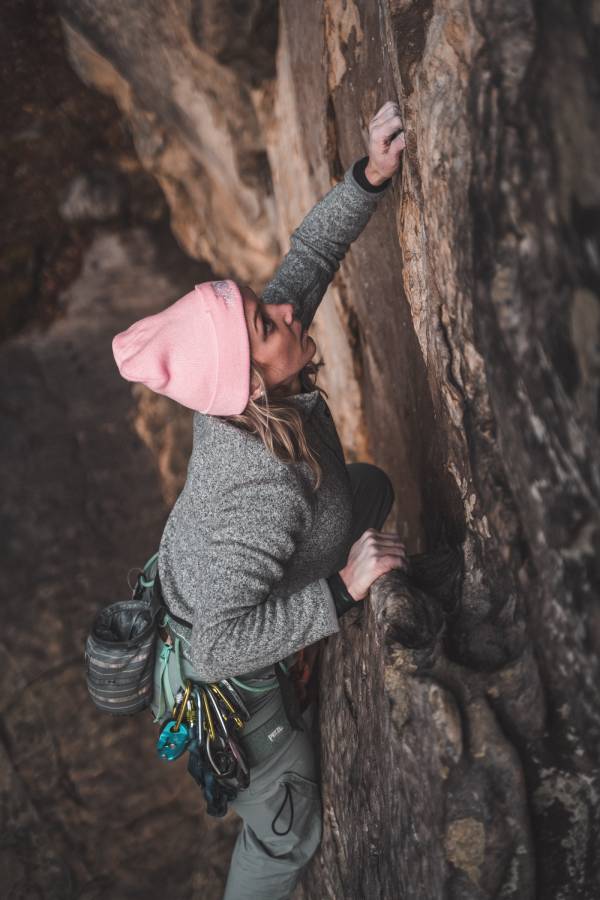This guide promotes the seven principles of LEAVE NO TRACE ethics for minimal impact while climbing.
This guide is intended to help recreational climbers, commercial climbing tour operators, and their clients improve their environmental management and reduce their impact on climbing sites.
IMPORTANCE:
Minimal impact techniques are important not only for environmental protection and the preservation of the wilderness, but also for the positive experience of outdoor enthusiasts.
Plan Ahead & Prepare
- Repackage Food. Plan your meals to reduce waste and leftovers. Repackage food into reusable containers or plastic bags to reduce the amount of potential waste.
- Carry Water. Water is a precious resource. Practice water conservation by carrying enough drinking water.
- Proper Equipment. Bring proper and adequate equipment to minimize your impact. Consider using a camp stove for cooking. Bring all the necessary equipment for washing dishes, straining dishwater, and carrying out waste.
- Safety. Bring all necessary safety equipment, such as helmets, first aid kits, satellite phones or Epirbs, warm clothes, torches, etc.
- Knowledge of the Area. Familiarize yourself with the weather and water conditions you may encounter.
- Know the regulations. Check with land managers or owners for information and special considerations, and obtain any necessary permits or permission. There may be a group size requirement.
- Before establishing a new climb, evaluate the impact carefully and consult with the land management authorities, if appropriate.
- Qualified Guides. Make sure your guides have adequate skills in first aid, safety, health, and hygiene, and are able to interact with clients. Guides should also have a basic knowledge of ecology to explain minimal impact practices.

Travel and Camp on Durable Surfaces
Climbing/Hiking:
- In pristine areas, take care to not create new trails. Spread out and walk carefully to avoid trampling.
- When approaching a climb, try to follow existing tracks and walk single file as much as possible to prevent widening the path.
- Avoid disturbing vegetation, including landscaping and excessive brushing.
- Plant Species: Familiarize yourself with local vegetation to learn about plants that are fragile and those that are resilient.
- Avoid Marking: Use accurate descriptions instead of marking the starts of climbs, which can be unsightly to non-climbers.
- Reduce Erosion: Use minimal impact techniques when traveling around cliff tops and bases to reduce erosion. Tread lightly and avoid sensitive vegetation such as mosses and bog plants at the base of the cliff, and heath areas at the top.
- Unloading Gear: Try to unload your gear and take breaks on large flat rocks or other durable surfaces to avoid damaging vegetation.
- Use “lower offs” where possible to avoid trampling of cliff top vegetation.
- Avoid areas that are being revegetated.
Rock Management:
- Avoid directly damaging rock by creating holds (e.g. trundling or chipping holds).
- Never alter the character of an existing climb by adding fixed protection or creating new climbs that require it.
- Use chalk sparingly as it creates a visual impact and kills surface algae, leaving bare rock.
- Fixed anchor points should be kept to a minimum and be discreet. They should not be used at all in National Parks and other conservation areas.
If trees are used as belay points, they must be protected from girdling, and there must be adequate padding between the belay point (sling, rope, etc.) and the tree.
Camping:
- If there is an established campsite, use it and avoid creating new ones.
- Otherwise, camp on rock, sand, or gravel where impact is minimal. When these can’t be found, then on areas with durable grasses or weeds.
- Avoid digging, landscaping, and trenching around tents.
- When leaving a campsite, “naturalize” it. Fluff up flattened grasses, brush away footprints, and replace any rocks that have been kicked or moved.
- Avoid damaging live shrubs, woody plants, or branches.

Dispose of Waste Properly
Rubbish:
- Minimise the amount of rubbish by planning ahead.
- Pack out all rubbish including organic kitchen waste.
- Do not burn rubbish.
- Remove all slings and pack out any small bits of climbing rubbish like finger tape.
Washing:
- Pans, cutlery and crockery should never be washed directly in water bodies. Wash 100 m from the edge of rivers and lakes.
- Pour used wash water through a fine mesh strainer to remove small food scraps to be carried out. Then scatter grey water on bushes, leaf litter or grassy areas, or into a small pit well away from water bodies.
- Use biodegradable detergent or preferably, no detergent at all. Instead, try using really hot water alone.
- Never use shampoo or soap in a river or lake. Try going without detergent for bathing If bathing is necessary, use buckets or bush showers at least 100m away from the water body.
- Hand washing for hygiene after toileting should also be done with biodegradable detergent at least 100 m away from water bodies. Hand sanitisers also work really well for this.
Toileting:
- Use toilets and other developed sites for human waste disposal if available.
- Most National Parks recommend burying waste in low-use areas. If this method is used, bring a trowel to dig a hole 10-15cm deep and 100m away from water and climbing routes.
- Use toilet paper sparingly, bury it deeply, or pack it out. Consider using natural alternatives such as smooth stones, grass, sticks, or non-irritating plant material that can be buried in the waste hole.
- Urinate on bare ground away from vegetation, climbing routes, and tracks
Leave What You Find
Respecting Culture
To respect the culture and ensure the longevity of Indigenous sites, avoid climbing close to them. Land managers can provide information on these locations.
Preserve Nature
- By leaving shells, feathers, flowers, fossils, artifacts, and other objects of interest as we find them, we preserve their natural beauty and pass on the gift of discovery to future generations.
- Learn about the ecological role that these objects play.
- Avoid climbing at sites where rare and vulnerable plants or animals are found. Land managers can provide information on these locations.
- Protect the special qualities of wilderness areas for the long-term.
Preserve the Past
It is illegal to excavate, disturb, or remove archaeological, historical, and cultural artifacts from public or wilderness lands.
Preventing the Spread of Non-Native Species
- Avoid spreading non-native plant and animal species, as they can be difficult to eradicate once introduced.
- Avoid spreading diseases like Giardia or Cryptospiridium by properly disposing of human waste at least 100 meters from water sources.
- Do not transport flowers, weeds, or aquatic plants into or out of wilderness areas.
- Empty and clean all gear, including packs, tents, pegs, boots, boats, fishing equipment, and vehicles, after each trip. Water, mud, and soil may contain harmful fragments like Phytophthora Cinnamoni (dieback fungus) or tiny plants and animals that can invade other ecosystems.
- Use wash stations if available.
- Inform landowners and managers of infested areas to help control the spread of harmful species.
- If traveling through areas known to contain pathogens, visit the uninfected area first.
Minimizing the Impact of Campfires
Building campfires can have negative impacts on the natural appearance of wilderness areas and contribute to the demand for firewood. Overflowing fire rings, littered with ashes, half-burnt logs, food, and trash, can be unsightly. Additionally, campfires can ignite bushfires.
Local Regulations
Before building a campfire, check with local landowners and managers to determine whether fire building is permitted and during which seasons.
Cooking
When possible, use a fuel stove for cooking instead of a campfire. Carry a lightweight stove and enough fuel for your cooking needs. A candle with a drip catcher can also be used for light.
Heat
Bring enough warm clothing so that you won’t need to rely on campfires for warmth
Minimal Impact Fires
If you choose to build a campfire, make sure it has minimal impact. Consider the wind, weather, location, and available wood before starting the fire. Use small dead pieces of wood found on the ground, and avoid breaking branches from trees or bushes.
If you build a fire in a pre-existing fire ring, dismantle and naturalize any extra fire rings. If there are no fire rings, consider building a mound fire. To do this, lay down a large ground cloth or fire pan, and collect sand, gravel, or soil with a low organic content. Use a stuff sack and trowel to construct a pedestal approximately 25 cm thick by 75 cm in diameter on the ground cloth or fire pan.
Burn all wood to ash, and make sure the fire is completely extinguished with water. Scatter the cold ashes widely, and disperse the soil.
Respect Wildlife
Education and Sensitivity
Learn about the role each species plays in its environment to understand the importance of their position in the ecosystem. As visitors, we have an impact on wildlife habitats, so it’s important to be aware of this impact.
Avoiding Nesting Sites
Avoid nesting sites of raptors during spring and summer. Watch for birds as they circle to identify crags to avoid. Observe wildlife from a distance to allow them to continue their normal activities such as feeding, hunting, or mating. Touching nests or young animals can cause their parents to abandon them.
Avoid Feeding Wildlife
Never feed wild animals, as this can lead to dependence or familiarity with humans, which can compromise their wildness. Store food and rubbish securely, and keep a clean camp.
Pets
Pets and wildlife do not mix. Keep pets at home and always check for pet regulations in national parks. Report any injured animals to local land managers, but do not attempt to handle the animal yourself.

Considerate Hosting and Visitor Behavior
Respect Your Hosts
Learn about the cultural and historical significance of the land and acknowledge and respect local knowledge and customs.
Outdoor Etiquette
The wilderness is shared with other outdoor enthusiasts, so it’s important to minimize negative impacts by examining our own behaviors.
Cooperative Attitude
In case of accidents, we often rely on others for help, and our experiences can be impacted by how we treat others and their attitudes towards us.
Low Impact Visiting
Take breaks in discreet locations to minimize impact on other groups. If possible, camp out of sight and sound from other visitors. Wear natural colors and avoid using brightly colored clothing and tents, which can disturb animals and other recreational users.
Preserve Natural Sounds
Keep noise to a reasonable level, and listen to the sounds of nature. Avoid using bright lights, radios, electronic games, mobile phones, and other urban devices that can be intrusive.
When in large groups, speak softly and set expectations and guidelines for behavior early in the trip.

